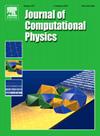A finite volume mesh-tying method for computing flows in rotor-stator configurations
IF 3.8
2区 物理与天体物理
Q2 COMPUTER SCIENCE, INTERDISCIPLINARY APPLICATIONS
引用次数: 0
Abstract
A finite volume mesh-tying method for the accurate, time-implicit calculation of flows in rotor-stator configurations is presented. We specifically reconsider the problem of coupling two moving domains with patched, but possibly non-conforming meshes at the common interface in a mass and momentum conserving manner. Here, the interfacial mass fluxes and tractions are considered as Lagrange multipliers that adjust instantaneously in such a way that the flow field remains continuous across the interface. For simplicity and computational efficiency, both the Lagrange multipliers and the corresponding continuity constraints for the velocity and pressure are collocated at a finite number of points along the mesh-tying interface. Concomitantly, an iterative augmentation scheme is invoked to eliminate the multipliers from the semi-discrete system of equations and shown to converge even for small values of the associated penalty parameter, thus preventing any deterioration in conditioning. If an iterative linear system solver is employed, then the augmentation is tantamount to the execution of additional solver iterations. Furthermore, our mesh-tying formulation maintains the sparsity of the system matrix and can be incorporated into existing block-structured flow solvers with a minimal implementational effort. For cylindrical grids with azimuthally equisized cells and matching axial grid lines, the mesh-tying approach is demonstrated to preserve the accuracy order of the spatial discretization scheme regardless of the degree of mesh disparity and to maintain long-term temporal accuracy. Finally, we employ the mesh-tying method to calculate unsteady flows in two- and three-dimensional baffled stirred tanks.
求助全文
约1分钟内获得全文
求助全文
来源期刊

Journal of Computational Physics
物理-计算机:跨学科应用
CiteScore
7.60
自引率
14.60%
发文量
763
审稿时长
5.8 months
期刊介绍:
Journal of Computational Physics thoroughly treats the computational aspects of physical problems, presenting techniques for the numerical solution of mathematical equations arising in all areas of physics. The journal seeks to emphasize methods that cross disciplinary boundaries.
The Journal of Computational Physics also publishes short notes of 4 pages or less (including figures, tables, and references but excluding title pages). Letters to the Editor commenting on articles already published in this Journal will also be considered. Neither notes nor letters should have an abstract.
 求助内容:
求助内容: 应助结果提醒方式:
应助结果提醒方式:


